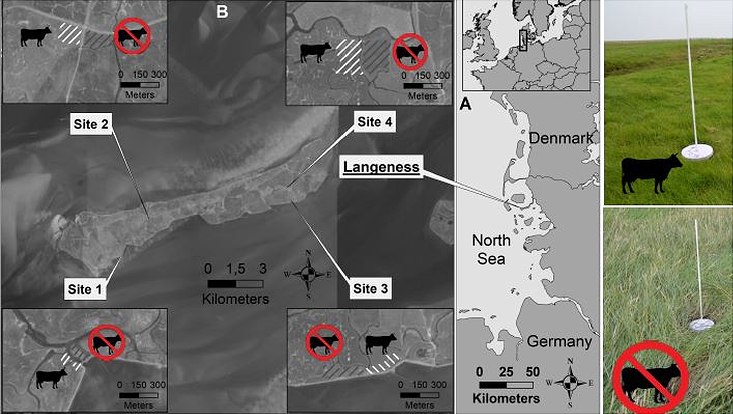Grazing increases vulnerability of Wadden Sea salt marshes to sea-level rise
1 February 2021, by Website Team Biologie

Photo: UHH/Bio
A team from the Institute of Plant Sciences and Microbiology led by Dennis Schulze found that vertical growth rates on ungrazed plots were up to seven times higher compared to grazed plots.
Coastal salt marshes are vegetated ecosystems which form a transition zone between the sea and the land. They serve as habitats for specific plant and animal species which are adapted to salt stress and regular flooding. Furthermore, they provide several important ecosystem services such as climate regulation (e.g. carbon storage) or coastal protection (e.g. wave damping).
However, these ecosystems and their provided ecosystem services are threatened by rising sea levels all over the world. In the Northern Wadden Sea region, a sea-level rise of 4 mm per year was recorded for recent years. To keep up with rising sea levels, marshes must grow vertically by accumulating sediment from the floodwater. Identifying and understanding factors that affect sediment accumulation and vertical accretion (vertical growth) of salt marshes is therefore crucial for the management of these ecosystems. On a anthropogenically altered (e.g. low seawall, livestock grazing) marsh island in the Wadden Sea (‘Hallig Langeneß’), vertical accretion was analyzed on grazed and adjacent ungrazed marsh areas.
After five flooding events within a year, mean sediment deposition and accretion were found to be up to seven times higher on ungrazed plots compared to grazed plots. It is concluded that grazing increases vulnerability of Wadden Sea salt marshes to sea-level rise by reducing the sediment trapping capacity of those marshes. These findings can be incorporated into future management plans for the studied island and for similar areas in the Wadden Sea or elsewhere.
Original publication:
Schulze D, Jensen K, Nolte S. 2021 Livestock grazing reduces sediment deposition and accretion rates on a highly anthropogenically altered marsh island in the Wadden Sea. Estuarine, Coastal and Shelf Science. https://doi.org/10.1016/j.ecss.2021.107191

